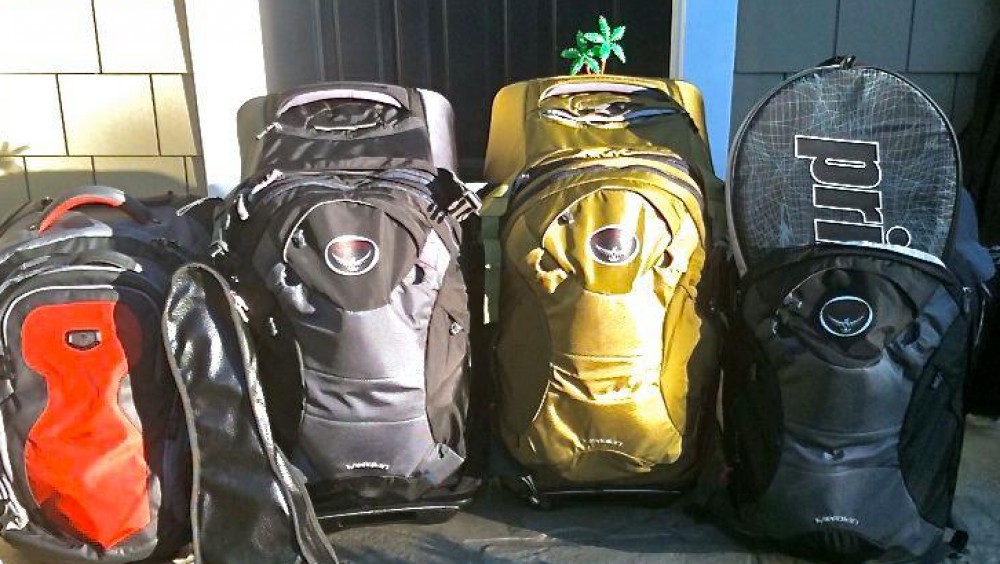Monthly Archives: June 2013
Getting Our Money’s Worth from our Japan Rail Passes
We spent our last week outside the States travelling on a Japan Rail pass. It is quite surprising to me that this was the most time we spent travelling on trains during the entire trip. Before this week, we had only taken 3 long distance train rides – Stroud to London 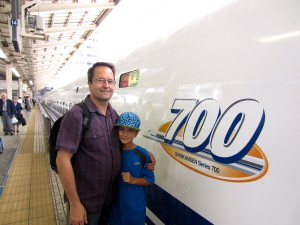 after our stay in the Cotswolds, and twice on the Eurostar chunnel train between London and Paris. Cars and planes have been our preferred mode of travel. Our reason for choosing the Japan Rail pass to travel in Japan was a simple choice. First, I had no desire to try and drive in Japan. Signs in Japanese, driving on the other side of the road like in the U.K., worrying about city driving and parking; this really made not driving a no-brainer. The other no-brainer for deciding was the legendary quality of the Japanese rail system – fast, efficient, extensive. When we began planning what we wanted to see outside of Tokyo, we only focused on Kyoto and Hiroshima. It was only to be a week, and we did not want to be moving around too much and, after all, Kyoto alone had enough to offer for a week’s stay. Hiroshima offered an incomparable educational opportunity about WWII, the
after our stay in the Cotswolds, and twice on the Eurostar chunnel train between London and Paris. Cars and planes have been our preferred mode of travel. Our reason for choosing the Japan Rail pass to travel in Japan was a simple choice. First, I had no desire to try and drive in Japan. Signs in Japanese, driving on the other side of the road like in the U.K., worrying about city driving and parking; this really made not driving a no-brainer. The other no-brainer for deciding was the legendary quality of the Japanese rail system – fast, efficient, extensive. When we began planning what we wanted to see outside of Tokyo, we only focused on Kyoto and Hiroshima. It was only to be a week, and we did not want to be moving around too much and, after all, Kyoto alone had enough to offer for a week’s stay. Hiroshima offered an incomparable educational opportunity about WWII, the 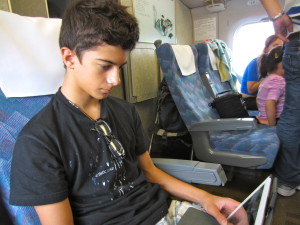 atomic bomb, and human resiliency. We estimated that even with the limited travel of Tokyo-Kyoto-Hiroshima-Tokyo, the Japan Rail pass would be cheaper than buying individual tickets. A week ticket for all of us, Justin being half price, cost exactly $1,000. We were loving Abenomics. The 103 yen to the dollar exchange rate was going to make our trip unexpectedly affordable, especially when compared to the prices in the Eurozone.
atomic bomb, and human resiliency. We estimated that even with the limited travel of Tokyo-Kyoto-Hiroshima-Tokyo, the Japan Rail pass would be cheaper than buying individual tickets. A week ticket for all of us, Justin being half price, cost exactly $1,000. We were loving Abenomics. The 103 yen to the dollar exchange rate was going to make our trip unexpectedly affordable, especially when compared to the prices in the Eurozone.
You have to buy Japan Rail tickets outside the country, and then Japan Rail sends you vouchers by mail that you redeem at a Japan Rail tourist office once inside the country. We ordered the tickets online when we were in Singapore, but had done this just before 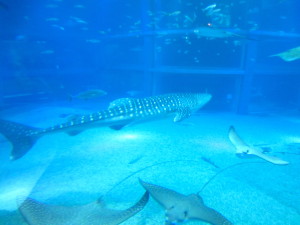 leaving for China. We had not done our homework on the second part of the process. Shades of our China visas again. We nixed the idea of sending the ticket vouchers to the Beijing hotel we were going to be staying at. What if they did not arrive, or the hotel staff simply misplaced the letter? Once again, our at-the-last-minute planning was causing us trouble, but as before the problem was manageable and we quickly found a solution. After reading the finer print of the instructions for the vouchers, we found we could have them mailed to a Japanese address. Gigi sent a quick e-mail to the owners of the apartment we would be staying asking if they would receive the letter with the passes for us, and they agreed. Even then, we still had some problems with the passes.
leaving for China. We had not done our homework on the second part of the process. Shades of our China visas again. We nixed the idea of sending the ticket vouchers to the Beijing hotel we were going to be staying at. What if they did not arrive, or the hotel staff simply misplaced the letter? Once again, our at-the-last-minute planning was causing us trouble, but as before the problem was manageable and we quickly found a solution. After reading the finer print of the instructions for the vouchers, we found we could have them mailed to a Japanese address. Gigi sent a quick e-mail to the owners of the apartment we would be staying asking if they would receive the letter with the passes for us, and they agreed. Even then, we still had some problems with the passes. 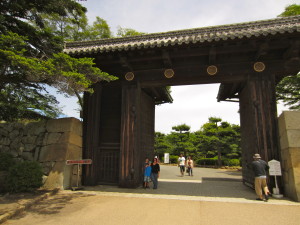 The Japanese way of addressing letters is, well, foreign to us, and in China we received and e-mail from Japan Rail that the letter could not be delivered. Another round of e-mails between Japan Rail and the apartment owners finally cleared the address obstacle. Our vouchers were waiting for us in Tokyo.
The Japanese way of addressing letters is, well, foreign to us, and in China we received and e-mail from Japan Rail that the letter could not be delivered. Another round of e-mails between Japan Rail and the apartment owners finally cleared the address obstacle. Our vouchers were waiting for us in Tokyo.
Google Maps became our Japan Rail travel agent. It is amazing that all the train timetables are loaded into this tool. Any problems we did have were user generated. The first trip from Tokyo to Kyoto went smoothly because we had made seat reservations when we turned in our vouchers for the actual rail tickets. Our only hiccup the entire week came with our trip from Kyoto to Hiroshima. We were going to try out riding in non-reserved cars. I did not – once again – pay attention to the finer print that the rail passes 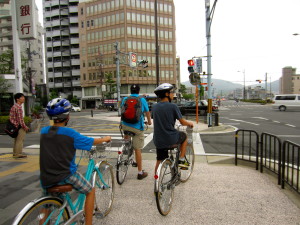 were not valid on Nozomi and Mizuho Shinkansen trains. My google maps travel agent gave me a Nozomi train for the trip, and when we arrived at the train station at the very last minute to jump on this train we were stopped by the conductor. We were out of breath and confused, but the conductor directed us to another track saying we would go to Shin Osaka and change trains there. OK, can do. The train left minutes later. Then, in Shin Osaka, when we got off the train and asked an agent for the train to Kyoto, he checked the time table and told us we had 3 minutes to catch the next train on a different track. Another mad dash through a train station ensued, and we made it into the train just as the doors were closing. After that day, we booked reserved seats in advance
were not valid on Nozomi and Mizuho Shinkansen trains. My google maps travel agent gave me a Nozomi train for the trip, and when we arrived at the train station at the very last minute to jump on this train we were stopped by the conductor. We were out of breath and confused, but the conductor directed us to another track saying we would go to Shin Osaka and change trains there. OK, can do. The train left minutes later. Then, in Shin Osaka, when we got off the train and asked an agent for the train to Kyoto, he checked the time table and told us we had 3 minutes to catch the next train on a different track. Another mad dash through a train station ensued, and we made it into the train just as the doors were closing. After that day, we booked reserved seats in advance 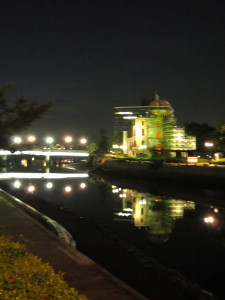 for the rest of our train rides.
for the rest of our train rides.
Before we even began our train journey, I began plotting how to get our money’s worth from the train passes. We ended up adding 3 new destinations to the original Tokyo-Kyoto-Hiroshima-Tokyo itinerary.
A ‘must see if you have kids travelling with you,’ recommendation from the Lonely Planet guide was to visit the Osaka Aquarium. Osaka is only 28 minutes from Kyoto on a rapid train. The whole trip door-to-aquarium took a little over one hour, but involved two JR trains, two subway trains and maybe 15 minutes of walking. Then, on the way home we decided to take another JR train out to the town of Arashyama on the west side of Kyoto. That trip took about 15 minutes from the Kyoto station. In one day, we had used our JR passes on 6 trains. That day is memorable because at the aquarium we saw a whale shark in the gigantic central tank, something that is very rare indeed in the world of aquariums. We live close to the Monterey Bay and San Francisco Steinhart aquariums, 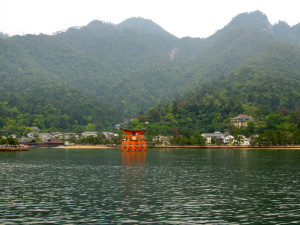 and visit these aquariums yearly. The whale shark rates up there with the Great White Shark that was in the Monterey Bay Aquarium and the albino alligator at the Steinhart Aquarium.
and visit these aquariums yearly. The whale shark rates up there with the Great White Shark that was in the Monterey Bay Aquarium and the albino alligator at the Steinhart Aquarium.
Our second added destination on the trip was to Miyajima Island. You can get to this island from Hiroshima station by taking a local train, then transferring to a JR ferry for a short ride to the Island. The ferry ride itself was worth the trip. The crossing took about 15 minutes. The ferry glides across a glassy waterway in the Inland Sea past floating oyster beds. 400-meter high mountains rise up from the land. That day was rainy with low, grey skies. The boys made the comment that the time and place reminded them of the fjord 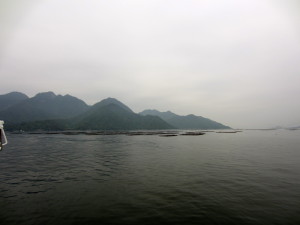 ride out of Geiranger, Norway. Funny, but true. The weather, water and land, and colors really did offer striking similarities. The ferry also makes a point of cruising past the famous floating torii gate that is the iconic image of Miyajima. We were passing it right at high tide, which is the perfect viewing time. We had tallied an additional two train rides and two ferry rides to our JR passes.
ride out of Geiranger, Norway. Funny, but true. The weather, water and land, and colors really did offer striking similarities. The ferry also makes a point of cruising past the famous floating torii gate that is the iconic image of Miyajima. We were passing it right at high tide, which is the perfect viewing time. We had tallied an additional two train rides and two ferry rides to our JR passes.
Our third and final added itinerary item proved to be our most ambitious, travel-wise. If we had stuck to the original travel plans, we would have simply returned along the same route that we had travelled south on, with no new sights seen.
We cut our stay in Hiroshima down to two days. I was trying to figure out how to see a 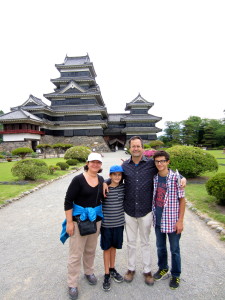 whole different region of Japan. Googling ‘beautiful train trips in Japan’ brought up discussion forums that promoted Shikoku Island and the northern part of Honshu. We only had two travel days, and I thought it would simply be too much train travelling to try and make it through these regions, then back to Narita airport. What seemed doable was to travel to the west coast of Honshu, then East across to Tokyo and Narita airport. I wanted to see the Japanese Alps on the trip across Honshu. The question was which town could we overnight at that would be interesting and compact enough for basically a half day visit. Kanazawa looked like the town to fit the bill, but instead a dark horse candidate won out: Matsumoto. Lonely Planet described it as a jumping off point for alpine hiking. It was a small town. It also had the oldest preserved castle in Japan and was rated one of the top four castles in the country. It was easy to reach from Hiroshima. Sold! We would be going to this town. We were not disappointed with the train ride. It followed valleys with fast flowing rivers and gave us views of mountains in the distance that still had snow on their two to three thousand meter peaks. The Matsumoto region is a grape and apple producing region, so we passed vineyards and orchards along with rice paddies.
whole different region of Japan. Googling ‘beautiful train trips in Japan’ brought up discussion forums that promoted Shikoku Island and the northern part of Honshu. We only had two travel days, and I thought it would simply be too much train travelling to try and make it through these regions, then back to Narita airport. What seemed doable was to travel to the west coast of Honshu, then East across to Tokyo and Narita airport. I wanted to see the Japanese Alps on the trip across Honshu. The question was which town could we overnight at that would be interesting and compact enough for basically a half day visit. Kanazawa looked like the town to fit the bill, but instead a dark horse candidate won out: Matsumoto. Lonely Planet described it as a jumping off point for alpine hiking. It was a small town. It also had the oldest preserved castle in Japan and was rated one of the top four castles in the country. It was easy to reach from Hiroshima. Sold! We would be going to this town. We were not disappointed with the train ride. It followed valleys with fast flowing rivers and gave us views of mountains in the distance that still had snow on their two to three thousand meter peaks. The Matsumoto region is a grape and apple producing region, so we passed vineyards and orchards along with rice paddies.
The next day, the Shinkansen out of Nagano took us back into the megalopolis of Tokyo, and the Narita Express out of Tokyo station took us to the airport. One last frenzy of travel before getting on the plane for Honolulu, and the States. After eleven months, our international travelling was at an end.
And Our Final Breakfast Outside the States is…McDonald’s ?!?!
It is a bit ironic that we should finish up the trip eating at McDonald’s. We never eat McDonald’s at home; we don’t like its food at all. However, we just did not want to eat another hotel buffet breakfast, and so as we left the New Station Hotel this morning with empty bellies the first place we saw for eats was the McDonald’s across the street from the train station. Egg McMuffins and milk sounded better than a bowl of noodle soup. Jordan surprised us by ordering a Fillet O’Fish sandwich. This was my mother’s favorite thing to 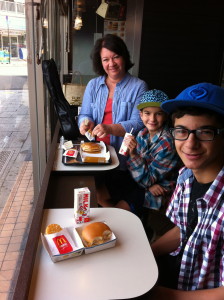 eat at McDonald’s when I was young. He wolfed it down, then ordered a second. Justin was able to order pancakes, and ate his whole meal and ordered a second milk. McDonald’s turned out to be the right choice for this final breakfast overseas. Somehow during the meal we got to talking about the nutritional value of McDonald’s food, and Gigi mentioned the movie about the guy who only ate McDonalds for a month. That would be the movie “Supersize That.” Jordan was very intrigued about how someone could make a movie just about eating McDonald’s food. Somewhere during the discussion, he exclaimed as he looked at his second, half-eaten Fillet O’Fish, “I’m feeling fat.” Want to feel fat? Try eating noodle soup twice a day for a week. Very tasty at first, but it starts to build on you. I don’t know how the Japanese stay so skinny. Could the answer be that they don’t eat it twice a day?
eat at McDonald’s when I was young. He wolfed it down, then ordered a second. Justin was able to order pancakes, and ate his whole meal and ordered a second milk. McDonald’s turned out to be the right choice for this final breakfast overseas. Somehow during the meal we got to talking about the nutritional value of McDonald’s food, and Gigi mentioned the movie about the guy who only ate McDonalds for a month. That would be the movie “Supersize That.” Jordan was very intrigued about how someone could make a movie just about eating McDonald’s food. Somewhere during the discussion, he exclaimed as he looked at his second, half-eaten Fillet O’Fish, “I’m feeling fat.” Want to feel fat? Try eating noodle soup twice a day for a week. Very tasty at first, but it starts to build on you. I don’t know how the Japanese stay so skinny. Could the answer be that they don’t eat it twice a day?
Another Temple to Visit Today?…Yessss!!!
This is not an exclamation you expect to hear from kids. The architecture does not thrill them. So what if the buildings are made from wood without nails. The color red is simply a color. A temple’s history definitely draws a blank for them, which I can actually understand 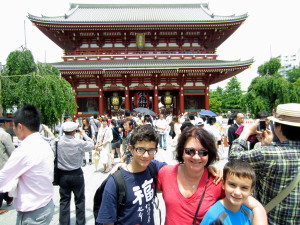 because we Westerners know so little about the important names in Japanese history. And the temples always seem to be very crowded. This disinclination towards temples is especially troublesome tourism-wise in Kyoto, which has 1600+ temples in the prefecture to visit. What is to be done?
because we Westerners know so little about the important names in Japanese history. And the temples always seem to be very crowded. This disinclination towards temples is especially troublesome tourism-wise in Kyoto, which has 1600+ temples in the prefecture to visit. What is to be done?
We managed to visit four temples during our visit to Japan. For sure, that was enough temple visiting for the boys. However, they did not howl in protest about going to these temples, even the last one.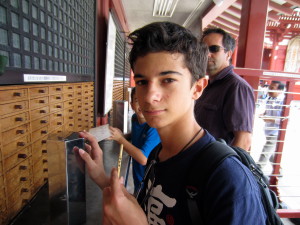
The first temple we visited was Asakusa in Tokyo. This temple is advertised as the most important temple in the city. A long, tourist-shop filled pedestrian avenue leads from the subway station to the temple. The red torii gates are imposing. We bribed the boys with ice cream before entering the temple. Since this was our first temple, everything about it was new and unfamiliar. Our focus at this temple became the customs we saw the Japanese practicing. Anything involving fire has a boy’s attention. We bought bundles of incense, lit them and placed them in a large 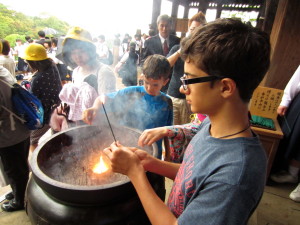 bronze cauldron with all the other bundles of burning incense. We used our hands to waft the incense smoke over our bodies. I am sure this has some purifying effect for the soul, but at the time we were just mimicking what others were doing. Next, we saw people shaking a metal tube then pulling sheets of printed paper out of a wall of drawers that looked like an overly large library card catalogue. This turned out to be a fortune telling system. Donate 100 yen then shake the metal tube until a stick falls out. The stick has Japanese writing on it. You match the characters on the stick to the characters printed on
bronze cauldron with all the other bundles of burning incense. We used our hands to waft the incense smoke over our bodies. I am sure this has some purifying effect for the soul, but at the time we were just mimicking what others were doing. Next, we saw people shaking a metal tube then pulling sheets of printed paper out of a wall of drawers that looked like an overly large library card catalogue. This turned out to be a fortune telling system. Donate 100 yen then shake the metal tube until a stick falls out. The stick has Japanese writing on it. You match the characters on the stick to the characters printed on 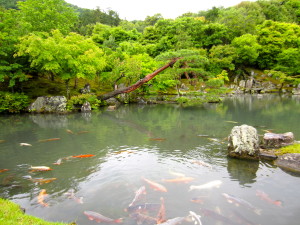 a drawer. Inside the drawer you find a fortune sheet. They are printed in several languages, including English. Justin received a ‘good’ fortune. Jordan was shocked to receive a ‘bad’ fortune. It basically told him not to get married, to stay home with the curtains closed. He wanted to be rid of this fortune, or at least get a new one, which we said ‘no’ to because learning to deal with the ‘bad’ is a life lesson and anyway we were not going to spend another 100 yen for another fortune for him. To round out the family, Gigi received an ‘excellent’ fortune, and I received a ‘moderate’ fortune, which really did not read much
a drawer. Inside the drawer you find a fortune sheet. They are printed in several languages, including English. Justin received a ‘good’ fortune. Jordan was shocked to receive a ‘bad’ fortune. It basically told him not to get married, to stay home with the curtains closed. He wanted to be rid of this fortune, or at least get a new one, which we said ‘no’ to because learning to deal with the ‘bad’ is a life lesson and anyway we were not going to spend another 100 yen for another fortune for him. To round out the family, Gigi received an ‘excellent’ fortune, and I received a ‘moderate’ fortune, which really did not read much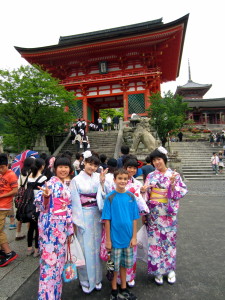 different from Jordan’s. I should not get married (too late) or go into a new business venture, but I could leave the house in relative safety. Farther into the temple, Jordan and I found that we could leave our fortunes tied on a bar inside the temple and ask for intervention from the Buddha to help block the negative vibes imparted by these fortunes. We left the temple, Gigi and Justin with a spring in their step, Jordan and I relieved that the sky was blue and absent of lightning bearing rain clouds.
different from Jordan’s. I should not get married (too late) or go into a new business venture, but I could leave the house in relative safety. Farther into the temple, Jordan and I found that we could leave our fortunes tied on a bar inside the temple and ask for intervention from the Buddha to help block the negative vibes imparted by these fortunes. We left the temple, Gigi and Justin with a spring in their step, Jordan and I relieved that the sky was blue and absent of lightning bearing rain clouds.
Our second temple visit occurred in Arashiyama, a western suburb of Kyoto. This area was recommended by one of Gigi’s friends on Facebook particularly for the bamboo forest. The other draw of this temple – Tenryuji – initially was its World Heritage designation, but what made the visit was the garden. We 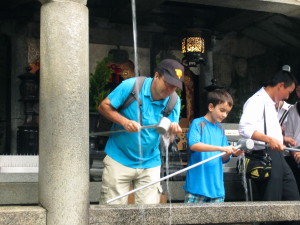 quickly walked past the temple buildings and paid little attention to the historical significance of the place. This strategy did pay dividends at times. There were giant koi in the small lake, something that always hooks Justin. The gardens were lush and green and backed by a further hillside of greenery. The city ended here. It was overcast and misty and cool. This environment energized Jordan. He loves being outdoors in leafy parks. Just outside the garden was the famous bamboo grove. There was a large walkway running through it and we decided to take the walk one by one in quiet
quickly walked past the temple buildings and paid little attention to the historical significance of the place. This strategy did pay dividends at times. There were giant koi in the small lake, something that always hooks Justin. The gardens were lush and green and backed by a further hillside of greenery. The city ended here. It was overcast and misty and cool. This environment energized Jordan. He loves being outdoors in leafy parks. Just outside the garden was the famous bamboo grove. There was a large walkway running through it and we decided to take the walk one by one in quiet 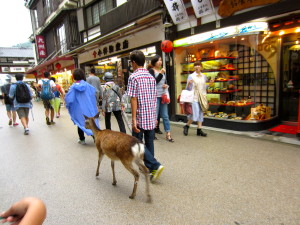 contemplation – yeah right! It was more to give Gigi and I some peace from Justin’s constant jabbering and Jordan’s teenager attitude. Down the hill through another park was the Hozu river. Jordan and Justin bounded down to the water’s edge and began looking for skipping stones. Although there were stones aplenty, flat and round skipping stones were very rare. Still, we had our skipping contest, then moved on to trying to hit a rock out in the river as many times as possible. During this temple visit I don’t think Jordan once leaned against a railing, resting his head against his hands in a posture of I’m-so-uninterested-and-tired.
contemplation – yeah right! It was more to give Gigi and I some peace from Justin’s constant jabbering and Jordan’s teenager attitude. Down the hill through another park was the Hozu river. Jordan and Justin bounded down to the water’s edge and began looking for skipping stones. Although there were stones aplenty, flat and round skipping stones were very rare. Still, we had our skipping contest, then moved on to trying to hit a rock out in the river as many times as possible. During this temple visit I don’t think Jordan once leaned against a railing, resting his head against his hands in a posture of I’m-so-uninterested-and-tired.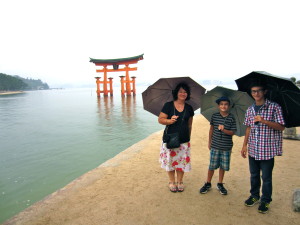
Our third temple visit was Kiyomizu-dera in Kyoto. We rented bikes this day and intended to temple hop along the west side of the city. Unfortunately, we did not pay close enough attention to the weather reports, and the overcast skies brought rain within an hour of the start of our ride. This temple was again crowded, this time with many school groups varying in ages from probably 10 to 14 years old. This created a different atmosphere for the boys. For once, they were surrounded by peers, and not the only non-adults in the throng. There were also several groups of young girls dressed in full kimono attire being hounded by people wanting to take their picture. We happened to get one of Justin surrounded by these “geisha wannabes.” This temple’s surroundings offered the same stunning arboreal background as Arashiyama. It was high upon a hill surrounded by greenery. Before entering the 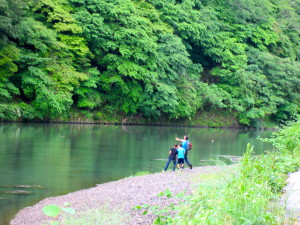 temple, we decided to take a small detour to walk down a dark hole called, the “Buddha’s Belly.” After paying our entrance fee, we took off our shoes, grabbed onto a rope handrail, and walked down some steep stairs that led to the beginning of a winding path or “Buddha’s Intestines.” The path is in pitch darkness and leads to a central room, “the belly,” where there is a large inscribed stone. We read beforehand that you are supposed make a wish while rubbing the stone and Buddha will reward your arduous journey by granting it. We rubbed the stone several times and made our wishes before continuing through the darkness to the exit staircase that led us back into the light. The wishing for good fortune continued at this temple with drinking from a sacred spring. Justin and I stood in line to take the metal cups attached to 3-foot sticks and filled them under the spring rivulets pouring from the rooftop above us. We finished our journey by walking a stone pathway to a red pagoda high in the hills beyond the temple. On the way down, we happened upon several kimono-clad ladies (the real deal), which added to the “old Japan” feeling of the place.
temple, we decided to take a small detour to walk down a dark hole called, the “Buddha’s Belly.” After paying our entrance fee, we took off our shoes, grabbed onto a rope handrail, and walked down some steep stairs that led to the beginning of a winding path or “Buddha’s Intestines.” The path is in pitch darkness and leads to a central room, “the belly,” where there is a large inscribed stone. We read beforehand that you are supposed make a wish while rubbing the stone and Buddha will reward your arduous journey by granting it. We rubbed the stone several times and made our wishes before continuing through the darkness to the exit staircase that led us back into the light. The wishing for good fortune continued at this temple with drinking from a sacred spring. Justin and I stood in line to take the metal cups attached to 3-foot sticks and filled them under the spring rivulets pouring from the rooftop above us. We finished our journey by walking a stone pathway to a red pagoda high in the hills beyond the temple. On the way down, we happened upon several kimono-clad ladies (the real deal), which added to the “old Japan” feeling of the place.
Our final temple visit was the Itsukushima on Miyajima Island. This is another World Heritage site and one of the top scenic spots in Japan. The floating tori gate is the centerpiece attraction, and it is quite a draw based on the number of tourist shops located on the main street of the small village. The hook for the boys here were the semi-wild deer that roamed freely through the town looking for food handouts. They were small deer, just waist high at their shoulders. They walked right up to us, followed us around, and let us touch them. They were quite endearing animals. The boys loved them. The floating tori shrine was an impressive sight. The island also has a gondola ride up to the 413m summit of the island with panoramic views of the Inland Sea and trails leading down to the village. Unfortunately, we had pretty constant rain this day and low clouds, so we skipped experiencing this part of the island.
I think the best strategy for visiting temples in Japan with kids is to make the visit not about the temple; it just happens to be there. It is window dressing. Advertise that you are going to burn things, challenge them to get a better fortune than dad, make lots of wishes, look for gardens and deer, and for boys, promise the holy grail of rock skipping on a river. They will absorb the spirituality and history of the place without really knowing it.
Sumo and Baseball
We had the opportunity to see two of Japan’s top sports, sumo wrestling and major league baseball. One is home grown, the other an import from America as a result of the post-WWII occupation. One features absurdly large athletes who don’t need to move more than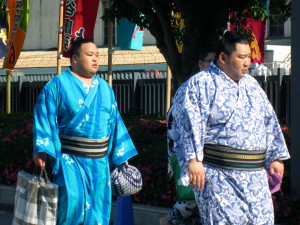 3 meters in any one direction; the other has leaner athletes who need to run at least 90 feet in a sprint at a time and range over a large grass field. Both sports require excellent eye-hand coordination and catlike reflexes. We enjoyed both events immensely, and perhaps for different reasons.
3 meters in any one direction; the other has leaner athletes who need to run at least 90 feet in a sprint at a time and range over a large grass field. Both sports require excellent eye-hand coordination and catlike reflexes. We enjoyed both events immensely, and perhaps for different reasons.
I knew that a sumo tournament was going on in Tokyo during the month of May when we were in the city. Tournaments only take place only three times a year in Tokyo, but they last for weeks. The tournament was in its last days, and the Lonely Planet guide said tickets become hard to get and required showing up to the stadium quite early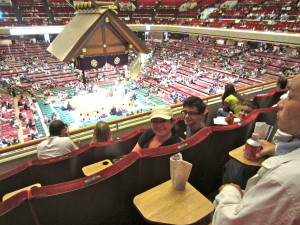 – 6 AM it said in the book. Watching a sumo match sounded cool, but not cool enough to get up and get to the stadium at that hour to buy tickets. (Only seeing giant blue fin tuna being cut up warrants getting up that early.) I put the idea of the sumo tournament on the back burner. Then, fate intervened. When we were at the Edo Tokyo museum there was a big sign in the ticket booth window, “No sumo tickets here.” I asked the ticket lady where could I buy sumo tickets and she pointed to the building next door. The Grand Sumo Ryogoku Kokugikan stadium was right next door! That was not in the LP guide,
– 6 AM it said in the book. Watching a sumo match sounded cool, but not cool enough to get up and get to the stadium at that hour to buy tickets. (Only seeing giant blue fin tuna being cut up warrants getting up that early.) I put the idea of the sumo tournament on the back burner. Then, fate intervened. When we were at the Edo Tokyo museum there was a big sign in the ticket booth window, “No sumo tickets here.” I asked the ticket lady where could I buy sumo tickets and she pointed to the building next door. The Grand Sumo Ryogoku Kokugikan stadium was right next door! That was not in the LP guide, 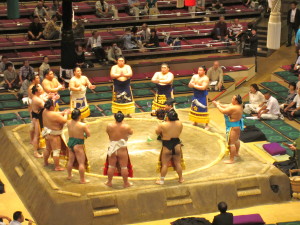 either. Before going in to the Edo Tokyo museum, we walked over to the sumo stadium to check on tickets. It was 10:30 AM. Tickets? No problem, the man told us. There were lots of tickets available. We bought nosebleed seats that were all-day passes, good from 10:30 AM until 8 PM. Elated that we were going to see sumo wrestling, we went on our visit of the Edo Tokyo museum. (Which, by the way, we got an English speaking docent who basically gave us a private tour of the museum.)
either. Before going in to the Edo Tokyo museum, we walked over to the sumo stadium to check on tickets. It was 10:30 AM. Tickets? No problem, the man told us. There were lots of tickets available. We bought nosebleed seats that were all-day passes, good from 10:30 AM until 8 PM. Elated that we were going to see sumo wrestling, we went on our visit of the Edo Tokyo museum. (Which, by the way, we got an English speaking docent who basically gave us a private tour of the museum.)
Because the opportunity to see sumo was so suddenly presented to us, we had not done any prior research on the sport. Gigi and I only knew some superficial things about sumo. 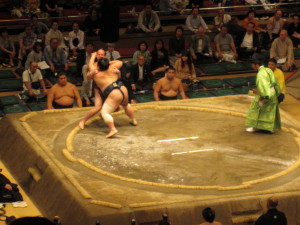 The boys’ entire knowledge of sumo came from the Austin Powers movie Goldmember. Justin kept making references to Fat Bastard during the matches. We entered the stadium about 1:00 PM. We were up on the upper level, but the stands were quite empty and so we did not bother trying to find our seats; we just took seats on the first row overlooking the lower seats and the sumo ring. Sumo matches were taking place at a brisk clip. Two wrestlers were waiting on the sidelines during each match. The actual wrestling of each match was over in seconds. The ceremony and posturing by the wrestlers preceding each match took much longer and built up the expectations for the seismic collision that followed. Although we would not be able to tell the finer points of sumo, we clearly could see that a throw down or push out of the ring meant victory. We saw a few judge’s decisions of matches, one even required the match being done over. That one was our last match and one of the wrestlers was a westerner. The first matches we saw were Jonokuchi Makushita division. Around 2:30, there was a changeover to the Juryo Rikishi class of professional sumo wrestlers. We watched the ceremonial entrance where all the Juryo Rikishi wrestlers come in wearing aprons and stand in a circle in the ring. We did not see the top classes of wrestlers – the Makuuchi Rikishi and Yokozuna – as their matches did not occur until the early evening, and we had already spent over two hours in the stadium watching sumo. Perhaps we missed something spectacular, but with our limited knowledge of sumo, who knows if we would have been able to discern the difference between a Juryo and Makuuchi bout.
The boys’ entire knowledge of sumo came from the Austin Powers movie Goldmember. Justin kept making references to Fat Bastard during the matches. We entered the stadium about 1:00 PM. We were up on the upper level, but the stands were quite empty and so we did not bother trying to find our seats; we just took seats on the first row overlooking the lower seats and the sumo ring. Sumo matches were taking place at a brisk clip. Two wrestlers were waiting on the sidelines during each match. The actual wrestling of each match was over in seconds. The ceremony and posturing by the wrestlers preceding each match took much longer and built up the expectations for the seismic collision that followed. Although we would not be able to tell the finer points of sumo, we clearly could see that a throw down or push out of the ring meant victory. We saw a few judge’s decisions of matches, one even required the match being done over. That one was our last match and one of the wrestlers was a westerner. The first matches we saw were Jonokuchi Makushita division. Around 2:30, there was a changeover to the Juryo Rikishi class of professional sumo wrestlers. We watched the ceremonial entrance where all the Juryo Rikishi wrestlers come in wearing aprons and stand in a circle in the ring. We did not see the top classes of wrestlers – the Makuuchi Rikishi and Yokozuna – as their matches did not occur until the early evening, and we had already spent over two hours in the stadium watching sumo. Perhaps we missed something spectacular, but with our limited knowledge of sumo, who knows if we would have been able to discern the difference between a Juryo and Makuuchi bout.
The boys were amazingly engaged in the event. They were betting 5 to 20 yen on each match. The loser of the previous match got to pick their choice for the next match. They identified their picks by either the color of the strings worn by the wrestler, or by giving them names, many of which were unflattering but accurately identified the wrestler – Sideburns, Western Guy, Moobs, Tiny, Mooby Dick, Potbelly, Wolverine, etc.
The next evening, we decided to attend a Yakult Swallows baseball game. They were 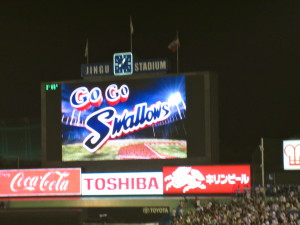 playing an interleague game against the SoftBank Hawks. The Swallows are to the Yomiuri Giants what the Mets are to the Yankees – the ‘other’ Tokyo team loved by its local fan base, but overshadowed by a richer and more successful cross-town team. The difference is that the Swallows and Giants are in the same league. The Swallows are in last place in their league, which means usually that tickets are not a problem to buy. We took the subway that let us off on the far side of the National Stadium, and we had to walk around this stadium to get to Jingu Ballpark. There was no one around and that got me to wondering just how poorly attended this game would be. Well, we must have taken
playing an interleague game against the SoftBank Hawks. The Swallows are to the Yomiuri Giants what the Mets are to the Yankees – the ‘other’ Tokyo team loved by its local fan base, but overshadowed by a richer and more successful cross-town team. The difference is that the Swallows and Giants are in the same league. The Swallows are in last place in their league, which means usually that tickets are not a problem to buy. We took the subway that let us off on the far side of the National Stadium, and we had to walk around this stadium to get to Jingu Ballpark. There was no one around and that got me to wondering just how poorly attended this game would be. Well, we must have taken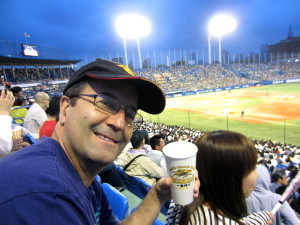 a route the regular fans avoided, because once inside the stadium, we saw that from first and third base around the outfield the stadium was sold out. We would never have guessed this from the outside, we did not find crowds until we were right at the stadium gates. We bought seats on the first base side just past first base and maybe 2/3 of the way up the stadium.
a route the regular fans avoided, because once inside the stadium, we saw that from first and third base around the outfield the stadium was sold out. We would never have guessed this from the outside, we did not find crowds until we were right at the stadium gates. We bought seats on the first base side just past first base and maybe 2/3 of the way up the stadium.
The ticket girl had asked us, “Swallow side or Hawks side?” “Swallow side!” I answered. I had no idea how important the question was. Of course, I was familiar with visitor sections for football and soccer games, and I did not want us to be crammed in with rabid travelling fans. We were not prepared with the fact that the stadium was split 50 – 50 from home 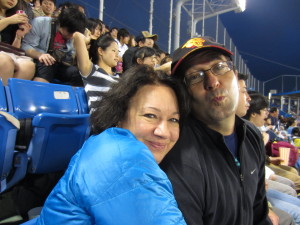 plate right down the middle of center field. When we got inside, the Hawks were batting. The sea of green on the third base side was chanting and clapping and waving banners. Horns were blowing. Our side, the home side, sat quiet. This was how Japanese fans operated. The at-bat side got to make all the noise. When the Swallows were up, our side erupted into sustained chanting, horn blowing and banner waving. One of the big screen ads featured Orlando Bloom saying how much he liked “takoyaki” – octopus puffs – with a diet coke. I had to buy a Kirin beer from one of the neon green clad, ponytailed girls carrying small kegs on their backs up and down the stadium stairs. For the 7th inning stretch, little girl and teenage cheerleaders took to the field for a brief show. The best was when a Swallow hit a home run. Our whole section broke out in song and
plate right down the middle of center field. When we got inside, the Hawks were batting. The sea of green on the third base side was chanting and clapping and waving banners. Horns were blowing. Our side, the home side, sat quiet. This was how Japanese fans operated. The at-bat side got to make all the noise. When the Swallows were up, our side erupted into sustained chanting, horn blowing and banner waving. One of the big screen ads featured Orlando Bloom saying how much he liked “takoyaki” – octopus puffs – with a diet coke. I had to buy a Kirin beer from one of the neon green clad, ponytailed girls carrying small kegs on their backs up and down the stadium stairs. For the 7th inning stretch, little girl and teenage cheerleaders took to the field for a brief show. The best was when a Swallow hit a home run. Our whole section broke out in song and 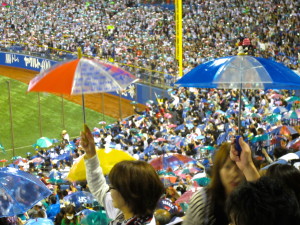 blossomed into a sea of mini umbrellas that bounced up and down. This was weird! Reading about this afterwards, the message is for the opposing pitcher to ‘head to the showers,’ and the ritual was described as ‘annoying.’ We thought it was brilliant! We got to see this one more time when a Swallow hit a 3 run homer and the ritual was repeated three times in a row. We finished off the evening with a Swallow victory, 4-3, which must have been very sweet for the home team fans as the Swallows have one of the worst records in Japanese baseball right now.
blossomed into a sea of mini umbrellas that bounced up and down. This was weird! Reading about this afterwards, the message is for the opposing pitcher to ‘head to the showers,’ and the ritual was described as ‘annoying.’ We thought it was brilliant! We got to see this one more time when a Swallow hit a 3 run homer and the ritual was repeated three times in a row. We finished off the evening with a Swallow victory, 4-3, which must have been very sweet for the home team fans as the Swallows have one of the worst records in Japanese baseball right now.
We were perhaps more entertained by watching the action in the stands than the action 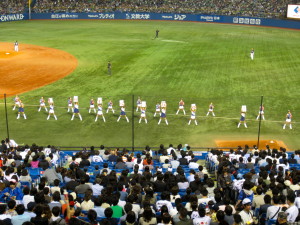 out on the field, but that does not mean that we did not see a good ballgame. There were not many strikeouts, and the pitchers mostly threw around 80 mph (130 Km/hr was a common radar gun reading, 150 Km/hr was probably the fastest pitch). We saw Japanese ‘small ball.’ Four bunts were attempted – two in the first two innings, but only one was successful. Three home runs were hit, all to deep center. The game got very tense for the home side when Swallows reliever almost blew his save, giving up a two run homer in the top of the 9th. He held on for the win, and the mini-umbrellas and the underage-not-ready-for-American-professional-sports cheerleaders came out onto the field. All the fans stayed for the end of the game, which was another big difference from American fans. Perhaps the 6 PM start/9 PM finish helps keep people from worrying about getting home too late, or maybe it is just not seen as polite to the players to leave early. They even take out all their trash from the stands when they leave and put it in trash bags at the exit gate.. How tidy and civilized!
out on the field, but that does not mean that we did not see a good ballgame. There were not many strikeouts, and the pitchers mostly threw around 80 mph (130 Km/hr was a common radar gun reading, 150 Km/hr was probably the fastest pitch). We saw Japanese ‘small ball.’ Four bunts were attempted – two in the first two innings, but only one was successful. Three home runs were hit, all to deep center. The game got very tense for the home side when Swallows reliever almost blew his save, giving up a two run homer in the top of the 9th. He held on for the win, and the mini-umbrellas and the underage-not-ready-for-American-professional-sports cheerleaders came out onto the field. All the fans stayed for the end of the game, which was another big difference from American fans. Perhaps the 6 PM start/9 PM finish helps keep people from worrying about getting home too late, or maybe it is just not seen as polite to the players to leave early. They even take out all their trash from the stands when they leave and put it in trash bags at the exit gate.. How tidy and civilized!
